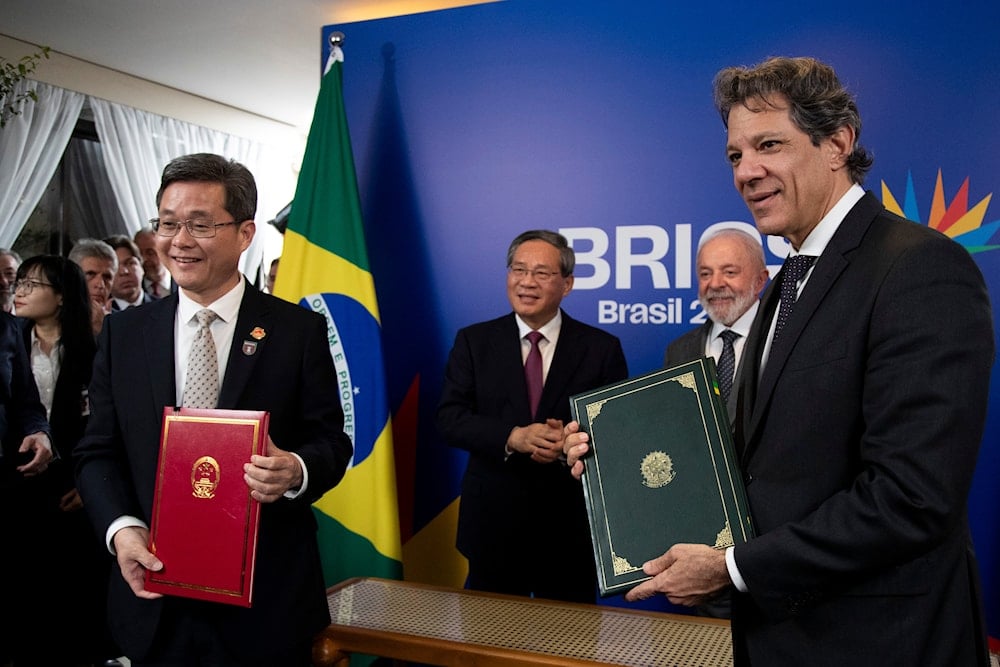Chinese $4.2 bln investment to power Brazil’s tech and energy growth
Chinese funding is reshaping Brazil’s economy, driving innovation in apps, green tech, and energy while creating new opportunities for bilateral trade.
-

China's Finance Minister and Brazil's Economy Minister Fernando Haddad pose for photo in front of China's Premier Li Qiang and Brazilian President Luiz Inacio Lula da Silva after the signing of a bilateral agreement in Rio de Janeiro, Saturday, July 5, 2025. (AP)
China’s growing investments in Brazil are set to strengthen the country’s innovation and technology industries, potentially driving new economic growth, The China Daily reported, citing government officials and private investors.
The Brazil-China Business Council reported this month that Chinese investment in Brazil reached $4.18 billion in 2024, nearly double the previous year’s figure.
Uallace Moreira, secretary of industrial development at the Ministry of Development, Industry, Trade and Services, said Brazil aims to leverage this capital to position itself both as a technology producer and a global investor.
“We see this growth as very positive, in a partnership that has been expanding for more than a decade,” Moreira said.
“The sources of these investments are diversifying, and Brazil is now the fifth-largest destination for foreign investment worldwide. This generates jobs and income.”
He added that Chinese funding has the potential to fuel innovation within Brazil’s industries.
“Brazilian and Chinese companies should move into more branches of the production chain, and it is up to the government to identify strategic sectors and create conditions for autonomous private sector growth,” he noted.
“App development, finance, green technology, power generation, and transmission, all these can impact related industries.”
Brazil also plans to expand outbound investment, with local firms already active in China in sectors such as coffee, proteins, food, cellulose, and electrical equipment through companies like WEG.
“With these two tracks, receiving and making investments, Brazil is building synergy for an innovative ecosystem, creating research centers, sending Brazilians to China, expanding their learning curve and adding value to the country’s production chain,” Moreira explained.
Private sector welcomes Chinese capital
Private investors also hailed the surge in Chinese participation. Ricardo Martins, chief economist at Planner Investimentos, said the momentum is reshaping bilateral economic ties.
“China, as Brazil’s main trading partner in recent years, has been opening doors for greater trade flows, especially with opportunities after US tariffs,” he said.
He emphasized the importance of market diversification. “This allows diversification of markets. Opportunities in agriculture, especially in meat. Also, renewable energy, infrastructure, and aerospace projects are coming from this increasingly close relationship,” he stressed.
According to Martins, Chinese engagement has already benefited a wide range of Brazilian exports.
“From soy, iron ore, meat to cars, doors have been opened for 183 Brazilian companies exporting to China. We can also add coffee, now penalized by a 50 percent US tariff, and looking for expansion in new markets,” he emphasized.
“This is an integration of interests aligned with each country’s strengths.”
Energy sector is at the forefront
A significant portion of Chinese funding has been directed to Brazil’s energy sector, where State Grid, China’s largest utility company, has invested about $5 billion since entering the market.
Ramon Haddad, vice-president of State Grid Brazil Holding, underlined the company’s long-term commitment.
“State Grid Brazil Holding has a long-term investment strategy in Brazil’s electricity sector. As we mark 15 years in Brazil, our strategy is reinforced through new projects,” Haddad said.
Currently, State Grid operates in 14 of Brazil’s 27 states plus the Federal District, supplying roughly 10 percent of the nation’s electricity, with more projects planned.
Haddad said new projects, primarily ultrahigh-voltage transmission systems, are expected, with an estimated total investment of $3.5 billion over the next four years.

 4 Min Read
4 Min Read










